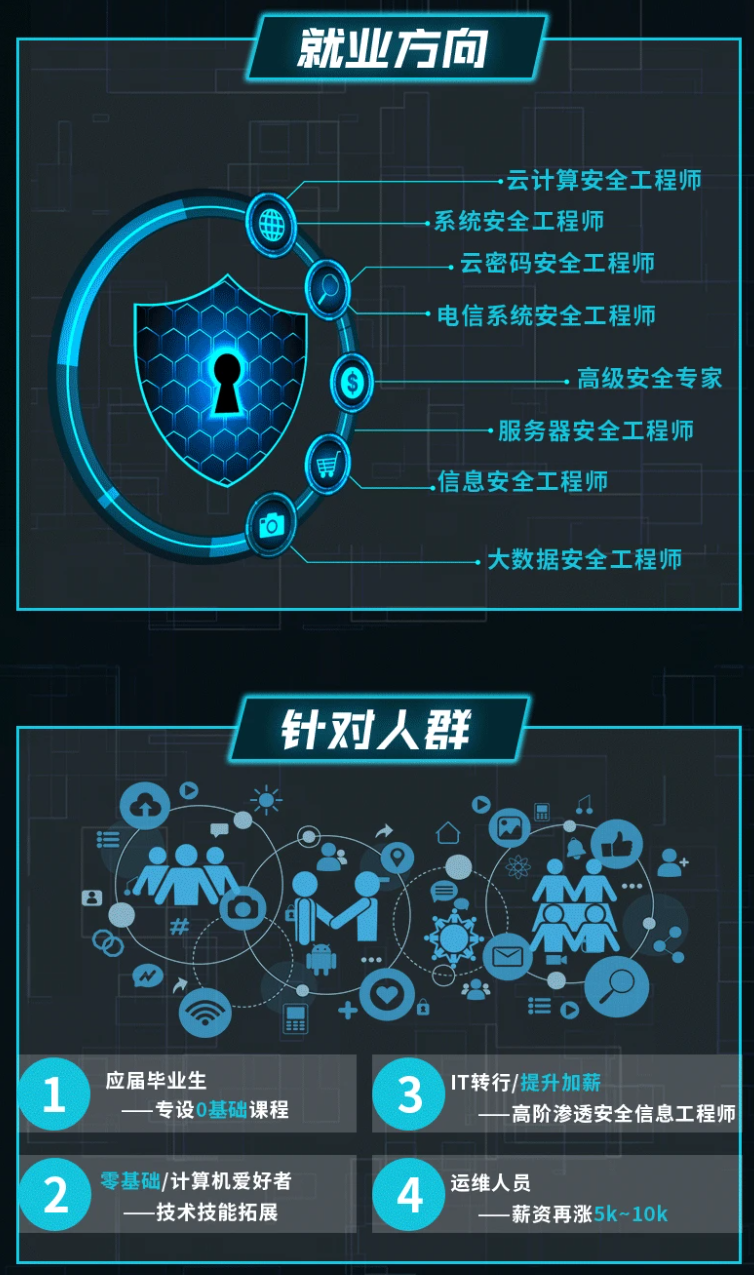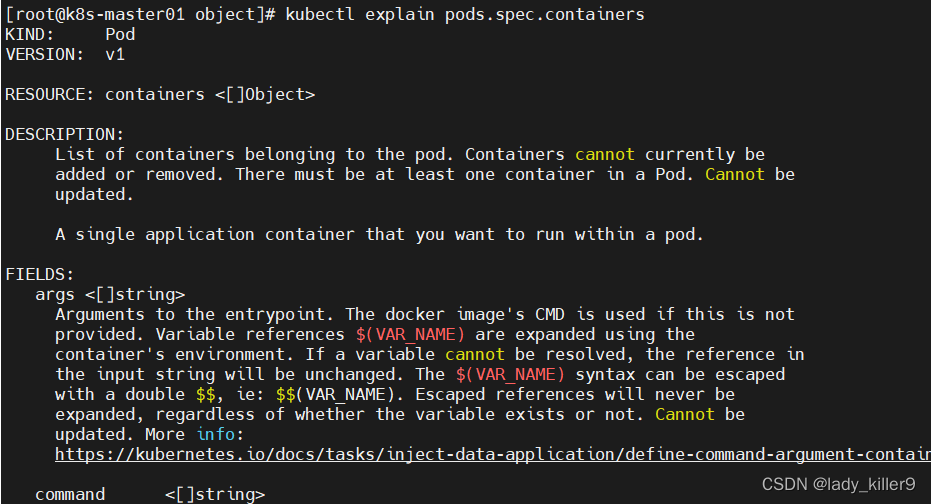
k8s学习-k8s资源对象与yaml结构_容器服务yaml配置 status
这个方向初期比较容易入门一些,掌握一些基本技术,拿起各种现成的工具就可以开黑了。
先自我介绍一下,小编浙江大学毕业,去过华为、字节跳动等大厂,目前阿里P7
深知大多数程序员,想要提升技能,往往是自己摸索成长,但自己不成体系的自学效果低效又漫长,而且极易碰到天花板技术停滞不前!
因此收集整理了一份《2024年最新网络安全全套学习资料》,初衷也很简单,就是希望能够帮助到想自学提升又不知道该从何学起的朋友。






既有适合小白学习的零基础资料,也有适合3年以上经验的小伙伴深入学习提升的进阶课程,涵盖了95%以上网络安全知识点,真正体系化!
由于文件比较多,这里只是将部分目录截图出来,全套包含大厂面经、学习笔记、源码讲义、实战项目、大纲路线、讲解视频,并且后续会持续更新
如果你需要这些资料,可以添加V获取:vip204888 (备注网络安全)

正文
可以看到,一个对象的yaml文件,一般包含apiVersion、Kind、metadata、spec和status(非必须)。
### api version
运行以下命令就能看到当前k8s支持的api版本,你的可能和博主不一样哈
**命令**
kubectl api-versions
**截图**

**文字版**
admissionregistration.k8s.io/v1
admissionregistration.k8s.io/v1beta1
apiextensions.k8s.io/v1
apiextensions.k8s.io/v1beta1
apiregistration.k8s.io/v1
apiregistration.k8s.io/v1beta1
apps/v1
authentication.k8s.io/v1
authentication.k8s.io/v1beta1
authorization.k8s.io/v1
authorization.k8s.io/v1beta1
autoscaling/v1
autoscaling/v2beta1
autoscaling/v2beta2
batch/v1
batch/v1beta1
certificates.k8s.io/v1beta1
coordination.k8s.io/v1
coordination.k8s.io/v1beta1
crd.projectcalico.org/v1
discovery.k8s.io/v1beta1
events.k8s.io/v1beta1
extensions/v1beta1
networking.k8s.io/v1
networking.k8s.io/v1beta1
node.k8s.io/v1beta1
policy/v1beta1
rbac.authorization.k8s.io/v1
rbac.authorization.k8s.io/v1beta1
scheduling.k8s.io/v1
scheduling.k8s.io/v1beta1
storage.k8s.io/v1
storage.k8s.io/v1beta1
v1
### Kind
Kind分为三类:
* **对象**代表系统中的持久实体。例如,Pod, ReplicationController, Service, Namespace等。
* **列表**是一种(通常)或多种(偶尔)类型的资源的集合。例如,PodList, ServiceList,等。
* **简单**种类用于对象上的特定操作和非持久实体。
具体支持哪些,可以查看[k8s学习-kubectl命令常用选项详解与实战]( )的资源类型一部分。
### metadata
#### 所有字段
metadata的所有字段如下:
annotations <map[string]string>
Annotations is an unstructured key value map stored with a resource that
may be set by external tools to store and retrieve arbitrary metadata. They
are not queryable and should be preserved when modifying objects. More
info: http://kubernetes.io/docs/user-guide/annotations
clusterName
The name of the cluster which the object belongs to. This is used to
distinguish resources with same name and namespace in different clusters.
This field is not set anywhere right now and apiserver is going to ignore
it if set in create or update request.
creationTimestamp
CreationTimestamp is a timestamp representing the server time when this
object was created. It is not guaranteed to be set in happens-before order
across separate operations. Clients may not set this value. It is
represented in RFC3339 form and is in UTC. Populated by the system.
Read-only. Null for lists. More info:
https://git.k8s.io/community/contributors/devel/sig-architecture/api-conventions.md#metadata
deletionGracePeriodSeconds
Number of seconds allowed for this object to gracefully terminate before it
will be removed from the system. Only set when deletionTimestamp is also
set. May only be shortened. Read-only.
deletionTimestamp
DeletionTimestamp is RFC 3339 date and time at which this resource will be
deleted. This field is set by the server when a graceful deletion is
requested by the user, and is not directly settable by a client. The
resource is expected to be deleted (no longer visible from resource lists,
and not reachable by name) after the time in this field, once the
finalizers list is empty. As long as the finalizers list contains items,
deletion is blocked. Once the deletionTimestamp is set, this value may not
be unset or be set further into the future, although it may be shortened or
the resource may be deleted prior to this time. For example, a user may
request that a pod is deleted in 30 seconds. The Kubelet will react by
sending a graceful termination signal to the containers in the pod. After
that 30 seconds, the Kubelet will send a hard termination signal (SIGKILL)
to the container and after cleanup, remove the pod from the API. In the
presence of network partitions, this object may still exist after this
timestamp, until an administrator or automated process can determine the
resource is fully terminated. If not set, graceful deletion of the object
has not been requested. Populated by the system when a graceful deletion is
requested. Read-only. More info:
https://git.k8s.io/community/contributors/devel/sig-architecture/api-conventions.md#metadata
finalizers <[]string>
Must be empty before the object is deleted from the registry. Each entry is
an identifier for the responsible component that will remove the entry from
the list. If the deletionTimestamp of the object is non-nil, entries in
this list can only be removed. Finalizers may be processed and removed in
any order. Order is NOT enforced because it introduces significant risk of
stuck finalizers. finalizers is a shared field, any actor with permission
can reorder it. If the finalizer list is processed in order, then this can
lead to a situation in which the component responsible for the first
finalizer in the list is waiting for a signal (field value, external
system, or other) produced by a component responsible for a finalizer later
in the list, resulting in a deadlock. Without enforced ordering finalizers
are free to order amongst themselves and are not vulnerable to ordering
changes in the list.
generateName
GenerateName is an optional prefix, used by the server, to generate a
unique name ONLY IF the Name field has not been provided. If this field is
used, the name returned to the client will be different than the name
passed. This value will also be combined with a unique suffix. The provided
value has the same validation rules as the Name field, and may be truncated
by the length of the suffix required to make the value unique on the
server. If this field is specified and the generated name exists, the
server will NOT return a 409 - instead, it will either return 201 Created
or 500 with Reason ServerTimeout indicating a unique name could not be
found in the time allotted, and the client should retry (optionally after
the time indicated in the Retry-After header). Applied only if Name is not
specified. More info:
https://git.k8s.io/community/contributors/devel/sig-architecture/api-conventions.md#idempotency
generation
A sequence number representing a specific generation of the desired state.
Populated by the system. Read-only.
labels <map[string]string>
Map of string keys and values that can be used to organize and categorize
(scope and select) objects. May match selectors of replication controllers
and services. More info: http://kubernetes.io/docs/user-guide/labels
managedFields <[]Object>
ManagedFields maps workflow-id and version to the set of fields that are
managed by that workflow. This is mostly for internal housekeeping, and
users typically shouldn’t need to set or understand this field. A workflow
can be the user’s name, a controller’s name, or the name of a specific
apply path like “ci-cd”. The set of fields is always in the version that
the workflow used when modifying the object.
name
Name must be unique within a namespace. Is required when creating
resources, although some resources may allow a client to request the
generation of an appropriate name automatically. Name is primarily intended
for creation idempotence and configuration definition. Cannot be updated.
More info: http://kubernetes.io/docs/user-guide/identifiers#names
namespace
Namespace defines the space within each name must be unique. An empty
namespace is equivalent to the “default” namespace, but “default” is the
canonical representation. Not all objects are required to be scoped to a
namespace - the value of this field for those objects will be empty. Must
be a DNS_LABEL. Cannot be updated. More info:
http://kubernetes.io/docs/user-guide/namespaces
ownerReferences <[]Object>
List of objects depended by this object. If ALL objects in the list have
been deleted, this object will be garbage collected. If this object is
managed by a controller, then an entry in this list will point to this
controller, with the controller field set to true. There cannot be more
than one managing controller.
resourceVersion
An opaque value that represents the internal version of this object that
can be used by clients to determine when objects have changed. May be used
for optimistic concurrency, change detection, and the watch operation on a
resource or set of resources. Clients must treat these values as opaque and
passed unmodified back to the server. They may only be valid for a
particular resource or set of resources. Populated by the system.
Read-only. Value must be treated as opaque by clients and . More info:
https://git.k8s.io/community/contributors/devel/sig-architecture/api-conventions.md#concurrency-control-and-consistency
selfLink
SelfLink is a URL representing this object. Populated by the system.
Read-only. DEPRECATED Kubernetes will stop propagating this field in 1.20
release and the field is planned to be removed in 1.21 release.
uid
UID is the unique in time and space value for this object. It is typically
generated by the server on successful creation of a resource and is not
allowed to change on PUT operations. Populated by the system. Read-only.
More info: http://kubernetes.io/docs/user-guide/identifiers#uids
常用的有以下几个:
* annotaions:注解。
* clusterName:集群名称。
* labels:标签。
* name:名称(namespace中唯一)。
* namespace:命名空间(大部分情况下使用kubectl中的-n指定,不写到yaml中)。
* ownerReferences:依赖于这个对象的其他对象。
* uid:唯一字符串。
这里再介绍下常用的label、annotations。
#### labels
**标签(Labels)** 是附加到 Kubernetes 对象(比如 Pods)上的键值对。 标签旨在用于指定对用户有意义且相关的对象的标识属性,但不直接对核心系统有语义含义。 标签可以用于组织和选择对象的子集。标签可以在创建时附加到对象,随后可以随时添加和修改。 每个对象都可以定义一组键/值标签。每个键对于给定对象必须是唯一的。
可以使用-l进行筛选:
**命令**
kubectl get po -n killer -l app=nginx
**截图**

#### annotations
你可以使用 Kubernetes 注解(Annotations)为对象附加任意的**非标识的元数据**。客户端程序(例如工具和库)能够获取这些元数据信息。
特点如下:
* 一般比label大
* 可以包含特殊字符
* 可以结构化也可以非结构化
### 帮助
如果yaml中的某个关键字不懂,可以使用explain命令进行详细解释。
**命令**
kubectl explain pods.spec.containers
**结果**

**containers全部内容**
KIND: Pod
VERSION: v1
RESOURCE: containers <[]Object>
DESCRIPTION:
List of containers belonging to the pod. Containers cannot currently be
added or removed. There must be at least one container in a Pod. Cannot be
updated.
A single application container that you want to run within a pod.
FIELDS:
args <[]string>
Arguments to the entrypoint. The docker image’s CMD is used if this is not
provided. Variable references $(VAR_NAME) are expanded using the
container’s environment. If a variable cannot be resolved, the reference in
the input string will be unchanged. The $(VAR_NAME) syntax can be escaped
with a double
,
i
e
:
, ie:
,ie:(VAR_NAME). Escaped references will never be
expanded, regardless of whether the variable exists or not. Cannot be
updated. More info:
https://kubernetes.io/docs/tasks/inject-data-application/define-command-argument-container/#running-a-command-in-a-shell
command <[]string>
Entrypoint array. Not executed within a shell. The docker image’s
ENTRYPOINT is used if this is not provided. Variable references $(VAR_NAME)
are expanded using the container’s environment. If a variable cannot be
resolved, the reference in the input string will be unchanged. The
$(VAR_NAME) syntax can be escaped with a double
,
i
e
:
, ie:
,ie:(VAR_NAME).
Escaped references will never be expanded, regardless of whether the
variable exists or not. Cannot be updated. More info:
https://kubernetes.io/docs/tasks/inject-data-application/define-command-argument-container/#running-a-command-in-a-shell
env <[]Object>
List of environment variables to set in the container. Cannot be updated.
envFrom <[]Object>
List of sources to populate environment variables in the container. The
keys defined within a source must be a C_IDENTIFIER. All invalid keys will
be reported as an event when the container is starting. When a key exists
in multiple sources, the value associated with the last source will take
precedence. Values defined by an Env with a duplicate key will take
precedence. Cannot be updated.
image
Docker image name. More info:
https://kubernetes.io/docs/concepts/containers/images This field is
optional to allow higher level config management to default or override
container images in workload controllers like Deployments and StatefulSets.
学习路线:
这个方向初期比较容易入门一些,掌握一些基本技术,拿起各种现成的工具就可以开黑了。不过,要想从脚本小子变成黑客大神,这个方向越往后,需要学习和掌握的东西就会越来越多以下是网络渗透需要学习的内容:

网上学习资料一大堆,但如果学到的知识不成体系,遇到问题时只是浅尝辄止,不再深入研究,那么很难做到真正的技术提升。
需要这份系统化的资料的朋友,可以添加V获取:vip204888 (备注网络安全)

一个人可以走的很快,但一群人才能走的更远!不论你是正从事IT行业的老鸟或是对IT行业感兴趣的新人,都欢迎加入我们的的圈子(技术交流、学习资源、职场吐槽、大厂内推、面试辅导),让我们一起学习成长!
越多以下是网络渗透需要学习的内容:

网上学习资料一大堆,但如果学到的知识不成体系,遇到问题时只是浅尝辄止,不再深入研究,那么很难做到真正的技术提升。
需要这份系统化的资料的朋友,可以添加V获取:vip204888 (备注网络安全)
[外链图片转存中…(img-XH071C7R-1713340409837)]
一个人可以走的很快,但一群人才能走的更远!不论你是正从事IT行业的老鸟或是对IT行业感兴趣的新人,都欢迎加入我们的的圈子(技术交流、学习资源、职场吐槽、大厂内推、面试辅导),让我们一起学习成长!
更多推荐
 已为社区贡献2条内容
已为社区贡献2条内容






所有评论(0)